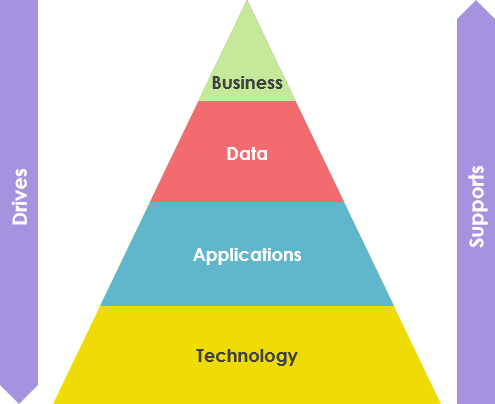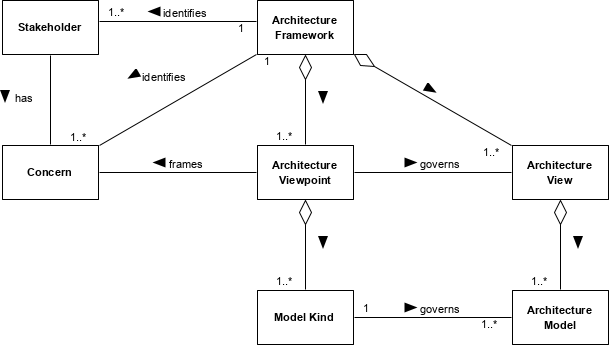BTOES From Home - SPEAKER ...
Courtesy of Nintex Pty's Paul Hsu, below is a transcript of his speaking session on 'Improve employee productivity during and post-COVID by ...
Enterprise architecture (EA) is "a well-defined practice for conducting enterprise analysis, design, planning, and implementation, using a comprehensive approach at all times, for the successful development and execution of strategy. Enterprise architecture applies architecture principles and practices to guide organizations through the business, information, process, and technology changes necessary to execute their strategies. These practices utilize the various aspects of an enterprise to identify, motivate, and achieve these changes."
Practitioners of enterprise architecture, enterprise architects, are responsible for performing the analysis of business structure and processes and are often called upon to draw conclusions from the information collected to address the goals of enterprise architecture: effectiveness, efficiency, agility, and continuity of complex business operations.
The goal of enterprise architecture is to create a unified IT environment (standardized hardware and software systems) across the firm or all of the firm's business units, with tight symbiotic links to the business side of the organization (which typically is 90% of the firm as seen earlier, at least by way of budget) and its strategy. More specifically, the goals are to promote alignment, standardization, reuse of existing IT assets, and the sharing of common methods for project management and software development across the organization. The end result, theoretically, is that the enterprise architecture will make IT cheaper, more strategic, and more responsive.
The Enterprise Architecture Body of Knowledge defines enterprise architecture as a practice, which
Analyzes areas of common activity within or between organizations, where information and other resources are exchanged to guide future states from an integrated viewpoint of strategy, business, and technology.
IT analysis firm Gartner defines the term as a discipline where an enterprise is led through change. According to their glossary,
"Enterprise architecture (EA) is a discipline for proactively and holistically leading enterprise responses to disruptive forces by identifying and analyzing the execution of change toward desired business vision and outcomes. EA delivers value by presenting business and IT leaders with signature-ready recommendations for adjusting policies and projects to achieve target business outcomes that capitalize on relevant business disruptions. EA is used to steer decision making toward the evolution of the future state architecture."
The purpose of enterprise architecture is to create a map of IT assets and business processes and a set of governance principles that drive an ongoing discussion about business strategy and how it can be expressed through IT. There are many different suggested frameworks to develop an enterprise architecture, as discussed later on. However, most frameworks contain four basic domains, as follows:
There is no shortage of EA frameworks in the IT industry, Zachman was the first to formalize the concept and publish a framework. Since then, many other EA frameworks have been published and are used by many organizations. They attempt to address the basic challenge of assessing, aligning, and organizing business objectives with technical requirements and strategies such as the Zachman Framework, The Open Group Architecture Framework (TOGAF), NAF, DoDAF, MoDAF and etc. Each framework possesses different strengths and weaknesses.
Enterprise architecture is unique to every organization, however, there are some common elements. Since Stephen Spewak’s Enterprise Architecture Planning (EAP) in 1993, and perhaps before then, it has been normal to divide enterprises architecture into four architecture domains.
The four commonly accepted domains of enterprise architecture are:
Business architecture domain – describes how the enterprise is organizationally structured and what functional capabilities are necessary to deliver the business vision. Business architecture addresses the questions WHAT and WHO: WHAT is the organization’s business vision, strategy, and objectives that guide creation of business services or capabilities? WHO is executing defined business services or capabilities?
Application architecture domain – describes the individual applications, their interactions, and their relationships to the core business processes of the organization. Application architecture addresses the question HOW: HOW are previously defined business services or capabilities implemented?
Data architecture domain – describes the structure of an organization’s logical and physical data assets and data management resources. Knowledge about your customers from data analytics lets you improve and continuously evolve business processes.
Technology architecture domain – describes the software and hardware needed to implement the business, data, and application services. Each of these domains have well-known artifacts, diagrams, and practices.

Business architecture domain – describes how the enterprise is organizationally structured and what functional capabilities are necessary to deliver the business vision. Business architecture addresses the questions WHAT and WHO:
Application architecture domain – describes the individual applications, their interactions, and their relationships to the core business processes of the organization. Application architecture addresses the question HOW: HOW are previously defined business services or capabilities implemented?
Data architecture domain – describes the structure of an organization’s logical and physical data assets and data management resources. Knowledge about your customers from data analytics lets you improve and continuously evolve business processes.
Technology architecture domain – describes the software and hardware needed to implement the business, data, and application services. Each of these domains have well-known artifacts, diagrams, and practices.
For many years, it has been common to regard the architecture domains as layers, with the idea that each layer contains components that execute processes and offer services to the layer above. Many EA frameworks combine data and application domains into a single information system layer, sitting below the business and above the technology (the platform IT infrastructure).
The scope of enterprise architecture includes: the people, business processes, information and technology of the enterprise, and their relationships to one another and to the external environment. Enterprise architecture applies architecture principles and practices to guide organizations through the alignment of these architecture domains: business, information, process, and technology. These involve utilize the various aspects of an enterprise to identify, motivate, and achieve these changes by performing:
An Architecture Framework establishes a common practice for creating, interpreting, analyzing and using architecture descriptions (Views and Viewpoints) within a particular domain of application or stakeholder community. It is a structure for the content of an Enterprise Architecture Description, according to the IEEE 1471 definition, we can describe an EA framework as the model shown below:

Utilizing an Enterprise Architecture framework streamlines the process for creating and maintaining architectures at all layers (e.g. enterprise architectures, functional business segment architectures, cross-cutting technology domain architectures, and solution architectures) and enables an organization to leverage the value of architecture best practices.
An Enterprise Architecture framework provides a collection of best practices, standards, tools, processes, and templates to assist in the creation of the Enterprise Architecture and architectures of various scopes. Enterprise Architecture frameworks typically include:
View our schedule of industry leading free to attend virtual conferences.
Each a premier gathering of industry thought leaders and experts sharing key solutions to current challenges.
Watch On-Demand Recording - Access all sessions from progressive thought leaders free of charge
from our industry leading virtual conferences.
The premier Business Transformation & Operational Excellence Conference. Watch sessions on-demand for free.
Use code: BFH1120
Delivered by the industry's most progressive thought leaders from the world's top brands.
Start learning today!
Welcome to BTOES Insights, the content portal for Business Transformation & Operational Excellence opinions, reports & news.
Insights from the most progressive thought leaders delivered to your inbox.
Insights from the world's foremost thought leaders delivered to your inbox.
Being a hero is all about creating value for others. Please invite up to 5 people in your network to attend this premier virtual conference, and they will receive an invitation to attend.
If it’s easier for you, please enter your email address below, and click the button, and we will send you the invitation email that you can forward to relevant people in your network.
View our schedule of industry leading free to attend virtual conferences. Each a premier gathering of industry thought leaders and experts sharing key solutions to current challenges.
View Schedule of EventsWatch On-Demand Recording - Access all sessions from progressive thought leaders free of charge from our industry leading virtual conferences.
Watch On-Demand Recordings For FreeDelivered by the industry's most progressive thought leaders from the world's top brands. Start learning today!
View All Courses NowThe premier Business Transformation & Operational Excellence Conference. Watch sessions on-demand for free. Use code: BFH1120
Watch On-DemandInsights from the most progressive thought leaders delivered to your inbox.
Insights from the world's foremost thought leaders delivered to your inbox.
Being a hero is all about creating value for others. Please invite up to 5 people in your network to also access our newsletter. They will receive an invitation and an option to subscribe.
If it’s easier for you, please enter your email address below, and click the button, and we will send you the invitation email that you can forward to relevant people in your network.
Courtesy of Nintex Pty's Paul Hsu, below is a transcript of his speaking session on 'Improve employee productivity during and post-COVID by ...
Read this article about HP, Best Achievement in Operational Excellence to deliver Digital Transformation, selected by the independent judging panel, ...
Read this article about BMO Financial Group, one of our finalists, in the category Best Achievement in Operational Excellence to deliver Digital ...
Read this article about Cisco, one of our finalists, in the category Best Achievement of Operational Excellence in Internet, Education, Media & ...
50 Grosvenor Hill. London W1K 3QT.
United Kingdom.
Copyright 2023 Proqis®